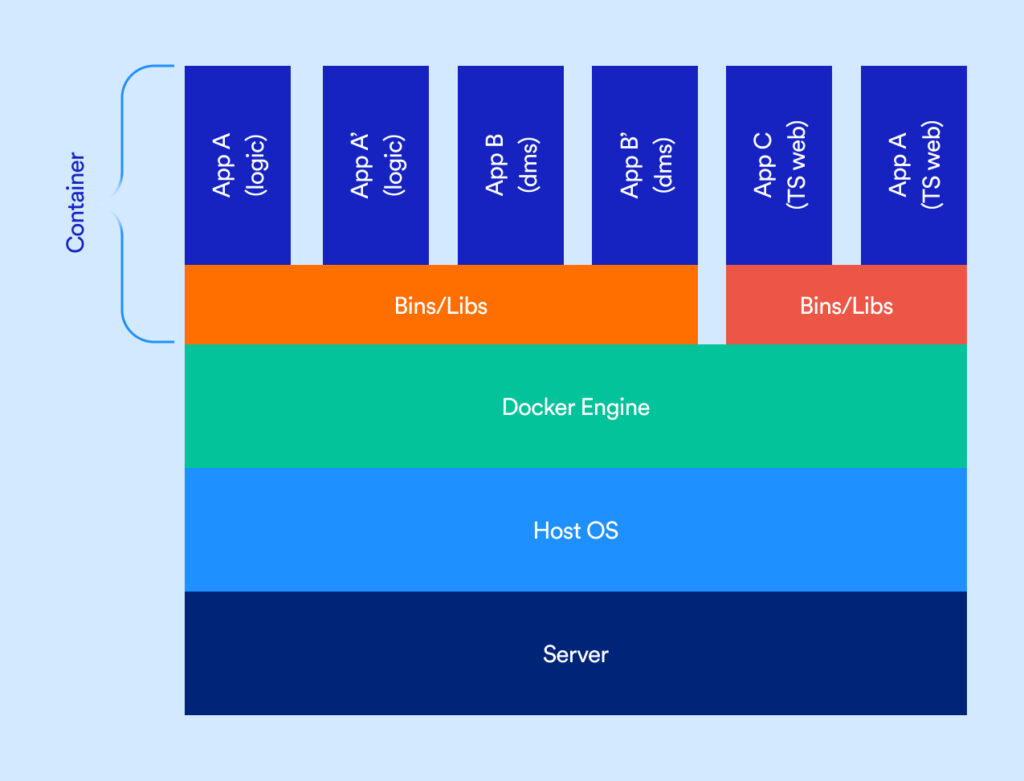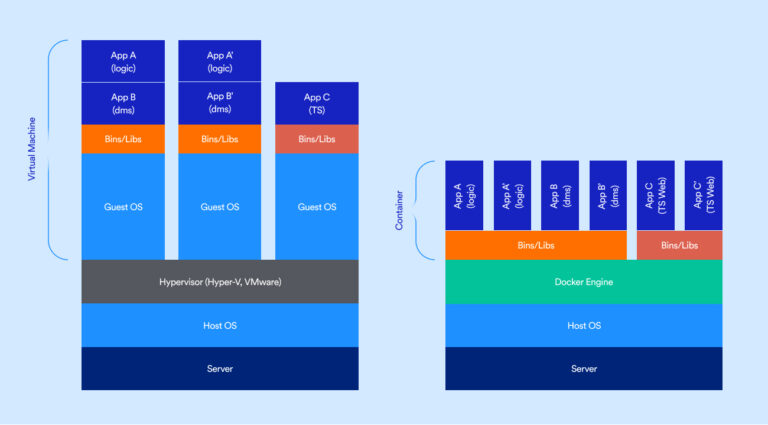In today’s market, software deployment is equally as important as software utility. For IT leaders in manufacturing, choosing a Manufacturing Execution System (MES) that aligns with modern infrastructure strategies, like containerization, can dramatically affect agility, scalability, and long-term cost of ownership.
At Parsec, we’ve built TrakSYS to offer the flexibility your infrastructure demands: supporting both traditional VM-based deployments and containerized services. Whether you’re running a centralized datacenter, a hybrid cloud architecture, or edge computing on the shop floor—TrakSYS is ready to meet you where you are and make your MES implementation as simple as possible.
But before diving into the benefits, let’s take a moment to explain what containerization actually means and how it may benefit your operations.
Table of Contents
What Are Containers?
You have just purchased a new blender—congrats! Now, picture in your mind the box this new blender comes in. In this box, there is everything you need to get started—the base, the pitcher, blades, and a user manual. Whether you unpack this blender in your kitchen or in your dining room makes no difference: no matter where you take the box, the blender inside will always work the same way because it has all the parts you need.
Now, from the software perspective, a container serves as a lightweight, portable, and self-sufficient package that contains everything needed to run a specific application or service, including:
- Code
- System libraries
- Dependencies
- Configuration
Containerization, then, refers to a deployment process that bundles an application as a single executable software package that includes all the files and libraries it needs to run on any operating system. Such containerized applications are “isolated” and operate on an open-source container runtime or container engine, instead of running an operating system within each application.
In summary, containerization enables application code to be written once and to run on any infrastructure.
Container Deployment Architecture
Containers have four key layers:
- Server (or another underlying IT structure)
- Host Operating System
- Container Engine (also known as a Container Image)
- The Container (including libraries/binaries and the application itself)

As this visual shows, libraries/binaries can be shared across multiple containers, which eliminates the need to run an operating system for each application, reducing the size and increasing the start up time of containers.
Containers vs. Virtual Machines
Another way to isolate software environments is Virtual Machines (VMs). However, the architecture of VMs is fundamentally different than containers, resulting in differencing capabilities, processing times, and more:

If a VM is a fully furnished house, a container, is a durable, personal tent—ready to go anywhere, fast and light. Additionally, multiple containers can share the host operating system kernel; this makes them far more resource efficient, and, in turn, may reduce server and licensing costs.

The Rise of Containerization in Enterprise IT
Containers have been around for some time, but they gained widespread popularity with the introduction of Docker and Kubernetes in the 2010s. These tools helped accelerate the adoption of technology by making it easier for development teams to package and deploy applications consistently across different environments. Today, containerization is a core element of many DevOps workflows and cloud-native architectures.
As digital transformation accelerates in manufacturing, IT leaders are increasingly adopting containers for MES and other industrial software. This shift is driven by the need to support distributed architectures, improve operational agility, and streamline application lifecycle management.
Before containers, developers would write code specific to a commuting environment, which often lead to bugs and errors when that code was transferred to a new environment. For example, moving an application from Linux® to a Windows operating system. Containerization makes moving applications easy by bundling the application code with all related configuration files, libraries and dependencies—therefore eliminating errors.
Today, more and more applications are being built as containers, and containers are being used to modernize existing applications for the cloud. In fact, almost three-quarters (74%) of U.S. infrastructure decision-makers say their firms are adopting containers within a platform as a service (PaaS) in an on-premises or public cloud environment.
TrakSYS and Containerization: Built for Flexibility
At Parsec, we’ve designed TrakSYS to meet evolving technology needs—whether they’re managing legacy infrastructure, modern containerized environments, or a mix of both.
Virtual Machine Installations
Well-suited for manufacturers with established server infrastructure or regulatory requirements that demand fully isolated systems. This option provides familiarity and control within existing IT frameworks.
Container-Based Deployments
Perfect for agile teams seeking faster provisioning, modular upgrades, and integration into DevOps workflows. Containers allow TrakSYS services to start in seconds, scale elastically, and be managed with orchestration tools.
We’ve already containerized TrakSYS core services, such as the Logic Service, enabling use with Docker and Kubernetes. These services can run independently or as part of a mixed-mode environment, giving IT leaders the flexibility to adopt containerization incrementally. TrakSYS supports both single-node and multi-node container deployments, allowing you to tailor your architecture to match your needs—whether on-premises, in the cloud, or at the edge.
Beyond core MES functionality, containerization allows TrakSYS to integrate more seamlessly with microservices, REST APIs, and modern data platforms. This extensibility enables organizations to enrich TrakSYS with new capabilities—like AI-powered analytics or third-party integrations—without disrupting core operations.
Benefits of Using TrakSYS in Containers
Containerization delivers meaningful operational benefits, including:
- Rapid Deployment & Scalability
Containers start quickly and can be replicated easily, supporting rapid scaling and high availability. - Consistent Environments
By packaging applications and their dependencies, containers ensure consistent performance across development, staging, and production. - Improved Resource Efficiency
Sharing the host OS kernel allows containers to use less system overhead, improving performance and reducing costs. - Flexible Deployment Options
Containers can be deployed across a variety of infrastructures—on-prem, in private or public clouds, or at the edge—without the need to reconfigure applications. - DevOps Alignment
Containers integrate seamlessly with continuous integration/continuous delivery (CI/CD) pipelines and infrastructure as code practices, enabling more efficient updates and testing cycles. - Security Enhancements
Containerization isolates services and applications, reducing the attack surface and making it easier to implement secure deployment practices.
When to Use Containers (and When You Don’t Have To)
Containerization brings significant advantages, but it’s not a one-size-fits-all solution. For some operations, traditional VM deployments may still be the best fit—especially in regulated industries or air-gapped networks.
Use containers when:
- You require rapid scalability and flexible resource allocation.
- You’re deploying across multiple environments (e.g., dev, test, prod) and want consistent results.
- Your team uses DevOps practices or continuous deployment.
- You’re moving toward microservices, edge computing, or hybrid cloud models.
Stick with virtual machines when:
- You operate in highly regulated environments and system-level isolation is mandated.
- Your current IT infrastructure is tightly coupled with traditional virtualization.
- Your team is not yet equipped to manage container orchestration tools like Kubernetes.
The key takeaway is flexibility. With TrakSYS, you don’t have to choose one or the other. Mixed-mode deployments let you combine the stability of VMs with the agility of containers—so you can evolve your infrastructure at a pace that aligns with your goals and resources.
Conclusion
In today’s rapidly changing IT landscape, manufacturers need an MES platform that doesn’t just fit into their existing infrastructure but also evolves with future strategies. TrakSYS is built with deployment flexibility at its core—empowering IT teams to choose between traditional VM installations or modern container-based deployments based on operational requirements, regulatory environments, and digital maturity.
From rapid scaling and portability to improved maintenance workflows and DevOps integration, containerization with TrakSYS offers real-world benefits that help manufacturing organizations stay competitive and resilient. And with support for hybrid deployments, TrakSYS ensures you’re never locked into a single strategy—you can grow and adapt at your own pace.
Ready to learn more about containerization with TrakSYS? Contact us today.

